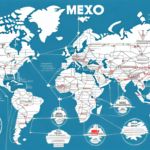Comparing UPS and USPS International Shipping Rates
International shipping is an essential service for businesses with a global customer base. Selecting the right shipping carrier can be a challenging decision, as there are many factors to consider, such as shipping speed, cost, and delivery reliability. UPS and USPS are two of the most popular shipping carriers in the US, both offering robust international shipping services. In this article, we will explore the pros and cons of each service and compare their international shipping rates to help you make an informed decision.
Introduction to International Shipping
International shipping involves transporting goods across international borders by air, sea, or land. Companies operating on a global scale rely heavily on international shipping to deliver products to customers worldwide. Compared to domestic shipping, international shipping is more complex due to customs regulations, taxes, and duties. The success of international shipping hinges on selecting a reliable and cost-effective carrier.
One of the biggest challenges in international shipping is navigating different languages and cultures. Understanding the customs and traditions of the destination countries, as well as any language barriers, can help avoid misunderstandings and ensure timely and safe delivery of products. Additionally, comprehending the necessary documentation, such as commercial invoices and bills of lading, is crucial. Proper documentation can prevent delays and ensure that your products clear customs without issues.
Understanding the Differences Between UPS and USPS
UPS and USPS are two prominent shipping carriers offering international shipping services. The primary difference between UPS and USPS is that UPS is a privately-owned company, whereas USPS is a government-owned postal service. This distinction often means that UPS provides more premium services at a higher cost, while USPS offers a wider reach at generally more affordable rates.
Another significant difference lies in delivery times. UPS typically offers faster delivery options than USPS, especially for international shipments, due to its extensive fleet of planes and trucks. However, USPS provides expedited shipping alternatives like Priority Mail Express International, which can be a cost-effective solution for businesses needing expedited delivery without the higher costs associated with UPS.
Additionally, UPS and USPS have different size and weight restrictions. UPS generally accommodates larger and heavier packages, whereas USPS offers flat-rate shipping options that are ideal for smaller, heavier items. USPS also has specific guidelines for shipping certain items, such as hazardous materials, which may not be accepted by UPS.
What to Consider When Choosing a Shipping Carrier
When selecting a shipping carrier for international shipments, consider factors such as delivery speed, cost, reliability, tracking capabilities, and insurance options. It's essential to evaluate the pros and cons of each carrier and compare their rates to determine the best fit for your business needs.
- Delivery Speed: Assess how quickly your shipments need to reach customers.
- Cost: Compare shipping rates and additional fees.
- Reliability: Look for carriers with a strong track record of on-time deliveries.
- Tracking: Ensure the carrier provides comprehensive tracking features.
- Insurance: Consider the insurance options available for your shipments.
Customer service is another critical factor. Opt for a carrier with responsive and helpful support teams that can assist with any issues during the shipping process.
Moreover, consider the environmental impact of your shipping choices. Select carriers that implement sustainable practices, such as eco-friendly packaging materials or using alternative fuel vehicles, to reduce your carbon footprint and promote sustainability.
A Breakdown of UPS International Shipping Rates
UPS offers a variety of international shipping services, including Express, Standard, and Expedited. The cost of UPS international shipping is influenced by factors such as destination, package weight, and shipping speed. For example, shipping a 5lb package from the US to Canada via UPS Express costs approximately $83.04, while the same package via UPS Standard is around $23.04.
UPS also provides additional services like customs clearance and insurance, which can increase the overall shipping cost but offer added security and peace of mind.
The delivery time with UPS varies by service. While UPS Express offers the fastest transit times, it may not always be necessary for all shipments. UPS Standard and Expedited services are suitable for packages that are not time-sensitive and require more affordable shipping options.
According to UPS’s latest 2023 report, their global network handles over 21 million packages daily, ensuring extensive coverage and reliability in international shipping (UPS Global Network).
A Breakdown of USPS International Shipping Rates
USPS provides several international shipping options, including Global Express Guaranteed, Priority Mail International, and First-Class Package International Service. Generally, USPS shipping costs are more affordable than UPS. For instance, shipping a 5lb package from the US to Canada via USPS Priority Mail International costs approximately $59.10, which is cheaper than the equivalent UPS Express service.
USPS offers free shipping supplies, such as boxes, envelopes, and labels, for their international shipping options, helping businesses save on packaging costs. Additionally, USPS provides free package pickup services, offering convenience and saving time and transportation costs.
According to the latest USPS International Mail Manual, USPS handles over 170 million international mail pieces annually, demonstrating their extensive international reach and reliability (USPS International Shipping).
Comparison of Rates for Common International Destinations
When comparing UPS and USPS rates for international shipping, it's crucial to consider common destinations and how costs vary based on the country, package weight, and shipping speed. For example, shipping a 5lb package from the US to the UK via UPS Express costs around $219.73, while USPS Priority Mail International charges approximately $78.90.
Different countries have varying restrictions on items that can be shipped. For instance, Australia has strict regulations on shipping food items, and it's essential to verify carrier and destination country’s customs regulations before shipping. Additionally, both UPS and USPS offer additional services such as package tracking, insurance, and signature confirmation for an extra fee. These services should be factored into your decision-making process when comparing rates and selecting a carrier.
According to export.gov, understanding specific country regulations can save time and prevent costly delays in international shipping.
How to Save Money on International Shipping Costs
International shipping costs can quickly accumulate, especially for businesses that frequently ship products overseas. Here are several strategies to reduce international shipping expenses:
- Use Flat-Rate Boxes: Take advantage of flat-rate shipping options to save on costs for heavy or bulky items.
- Ship in Bulk: Consolidate shipments to benefit from discounted bulk shipping rates.
- Negotiate Rates: Work with carriers to negotiate better rates based on your shipping volume.
- Leverage Technology: Utilize shipping calculators and comparison tools to find the most cost-effective rates.
- Third-Party Fulfillment Services: Partner with fulfillment services that offer discounted shipping rates.
Alternative shipping methods can also help save money. For example, opting for sea freight instead of air freight for larger shipments can significantly reduce costs, albeit with longer transit times. Additionally, some carriers offer discounted rates for specific destinations or during off-peak shipping periods, so thorough research can uncover substantial savings.
Additional Fees and Surcharges to Consider
When shipping internationally, it’s essential to account for additional fees and surcharges that may apply. These costs include:
- Customs Duties: Fees imposed by the destination country on imported goods, based on the value and type of products.
- Taxes: Value-added tax (VAT) or goods and services tax (GST) applied by the destination country.
- Fuel Surcharges: Additional fees to cover fluctuating fuel costs.
- Handling Fees: Charges for processing and handling international shipments.
- Insurance: Costs associated with insuring shipments against loss or damage.
Customs duties and taxes vary by country and product type, so it’s crucial to research the specific requirements of the destination country before shipping. This ensures accurate cost calculations and prevents unexpected expenses.
For detailed information on international shipping fees, refer to the Customs Duties Information from reputable sources.
Transit Times for UPS and USPS International Shipments
Transit time is the duration it takes for a package to travel from the sender to the receiver. UPS generally offers faster transit times than USPS for international shipments. For example, shipping a package from the US to the UK via UPS Express typically takes one business day, whereas USPS Priority Mail International may take six to ten business days.
Choosing the right service based on your delivery time requirements can impact customer satisfaction and operational efficiency. Evaluate your business needs to determine whether faster transit times justify the additional cost.
Recent data from UPS indicates an average on-time delivery rate of 98% for international Express shipments, highlighting their reliability (UPS International Services).
Tracking and Delivery Confirmation Options
Both UPS and USPS provide tracking and delivery confirmation for their international shipments, allowing businesses and customers to monitor the progress of their packages.
- UPS: Offers real-time tracking and delivery confirmation through its online portal. Customers can receive updates via email or SMS and access detailed tracking information.
- USPS: Provides tracking through its website and email notifications. While USPS tracking is comprehensive, it may not be as granular as UPS’s real-time tracking.
Effective tracking helps ensure on-time delivery and allows businesses to proactively address any issues that may arise during transit.
For enhanced tracking features, consider exploring advanced shipping software that integrates with both UPS and USPS tracking systems.
Customer Support and Service Options for UPS and USPS
Customer service quality can significantly impact your shipping experience. Here’s how UPS and USPS compare:
- UPS: Provides dedicated customer service representatives and a 24/7 toll-free phone number. They also offer online chat support and comprehensive online resources, including FAQs and customer forums.
- USPS: Offers a general customer support line and email support. While USPS customer service is generally reliable, it may not be as specialized or responsive as UPS’s dedicated support.
Both carriers offer extensive online resources to help customers troubleshoot common issues and access shipping tools.
How to Choose the Right Carrier for Your Business Needs
Selecting the right shipping carrier depends on various factors, including shipping volume, destination countries, budget, and required service levels. Consider the following when choosing between UPS and USPS:
- Shipping Volume: High-volume shippers may benefit from UPS’s scalable solutions and negotiated rates.
- Destination Countries: Evaluate which carrier offers better rates and services for your primary international markets.
- Budget: USPS generally provides more affordable shipping options, especially for smaller packages.
- Service Levels: Determine whether you need expedited services, tracking accuracy, and insurance options.
Partnering with a third-party logistics provider or fulfillment service can also help in selecting the most suitable carrier, as they offer expertise and access to negotiated shipping rates.
Case Studies: Real-Life Examples of Choosing UPS or USPS for International Shipping
Real-life examples can illustrate how businesses choose between UPS and USPS based on their specific needs:
- High-Value Items: A jewelry business may prefer UPS for its extra security features, faster transit times, and comprehensive insurance options to ensure the safe delivery of high-value items.
- Lower-Value Items: A clothing retailer might opt for USPS due to its more affordable rates and sufficient delivery times for medium-value goods.
- Bulk Shipments: A manufacturing company shipping large quantities of parts internationally may choose UPS for its ability to handle larger and heavier packages efficiently.
These examples demonstrate that the choice between UPS and USPS depends on the nature of the products, budget constraints, and specific shipping requirements of the business.
Conclusion: Which Carrier is Best for Your Business?
Both UPS and USPS offer reliable and cost-effective options for international shipping, but the right carrier for your business depends on several factors, including shipping volume, destination countries, budget, and desired service levels. UPS is ideal for businesses requiring faster delivery times, higher package weight limits, and advanced tracking and insurance options. Conversely, USPS is suitable for businesses looking for more affordable shipping rates, especially for smaller packages.
By carefully evaluating the pros and cons of each carrier and comparing their rates and services, you can select the best shipping partner to meet your business needs and enhance your global customer satisfaction.






















